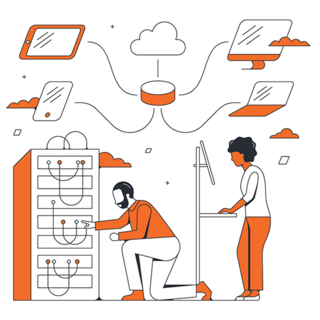In the past, it wasn’t unheard of for software development cycles to last 18 months or more. Today, companies are expected to develop and release new apps and services more often and with fewer resources. This puts organizations under a lot of pressure to deliver high-quality, innovative solutions in increasingly shorter development cycles.
In an effort to keep up, you’ll need to hire a stable of talented, experienced programmers. But there are a couple of problems you’ll have to overcome:
- With the current global shortage of talented software developers, where will you find enough programmers to keep up with demand?
- If you can find enough experienced, skilled developers, where will you get the money to pay them?
This is where low code development comes in. Developing apps and services with a low code platform does not require the developer to have extensive knowledge of programming languages, or expert experience with entering code by hand.
In this article we’ll discuss how taking a low code approach to software development can help you be more agile, do more with less, and develop and deliver high-quality products very quickly.
What is low code?
Low code development (also called low-code) is a modular, graphical approach to software development. Instead of entering a lot of complex code by hand, developers with various levels of experience can quickly develop apps and processes using drag and drop features, model-driven design, and automatic code generated in a visual interface.
Low code is gaining popularity because it enables employees with little experience in coding to create fully functional applications very quickly. In fact, Gartner estimated that by 2024 65% of application development will be done using low code development platforms.
Why use a low code development platform?
Low code does not mean no code. Depending on what you are trying to accomplish, you may need to add some custom code even when working with a low code development platform.
Low code platforms consist of a set of tools—a tech stack—that allow you to develop and deliver functional web and mobile apps in a visual way. There is a lower learning curve for using tools because you don’t have to write thousands of lines of code. This means that you can leverage the skills of existing staff to produce a larger number of apps in a shorter amount of time.
You save time and money because you don’t have to search for and hire expert-level programmers. And the faster development and delivery cycle satisfies customer demands and meets their expectations.
What does a low code development platform look like?
There is a variety of low code software available and no two are alike. But a typical low code development platform will have the following features:
A visual IDE (integrated development environment): A visual interface is essential for a low code platform. The environment should include visual elements that define the UI and application workflows. Drag and drop features make it easy to combine preconfigured elements so you can build solutions that address customer needs.
You should be able to add hand-written code to the various models and elements to customize your app when necessary. The beauty of this is that these customized models can be saved and reused later when building future apps.
A good place to start is with a virtual drawing canvas like Lucidchart. The templates and shapes libraries make it easy to visualize your ideas, draw workflows, and create mockups before you begin creating the app. Lucidchart promotes collaboration and feedback as you work together to ideate and determine what problems your new application will solve.
Connectors to backend services and processes: Low code platforms should be able to automatically connect to website and application backends and handle data storage and retrieval.
Application lifecycle manager: This includes tools that automate application builds, deployment, and testing.
Traditional application development vs. low code
Traditional application development usually involves a large team and requires skilled developers with extensive knowledge of technologies, system frameworks, and architecture.
These software developers write thousands of lines of code by hand, with each team member working on a different part of the product. They have to pay attention to detail to ensure that the syntax is correct so that the app will build correctly when all the different parts are brought together.
It is a labor-intensive and time consuming process. To speed up and streamline the process, developers will often use existing code that solves a problem they are working on.
This parallels the concept of low code development. Somebody has already written some code that solves the problems you need to address. This code has been saved in pre-built, reusable modules that are now the building blocks for your future projects. All you have to do is grab the modules you need to build your new app or service.
But just because you can grab a bunch of modules and start building right away doesn’t mean that you should. Just like with traditional development you still need a plan. You will still need to gather requirements, ask for feedback, build prototypes, and so on.
After you have a plan, you can grab the modules that align with your business goals and requirements and begin building your new product. Because nobody has to spend a lot of time writing complex code, the application development is faster and products are available to customers much more quickly.
What are the drawbacks of low code development?
Low code development has a lot of benefits like increased productivity, faster development, agility, easy deployment, fewer resources, reduces costs, etc. But there are also some drawbacks to consider when determining if low code is right for you.
Security: Most low code platforms are available from the cloud, meaning that they typically include security and access controls by default. These default settings can make it easier to create secure apps. But people can still make mistakes. Also, just because very little code is involved does not mean that the apps you create are automatically more secure.
Shadow IT: Low code platforms open up development to a wider range of people. Some apps could be developed and deployed without IT’s knowledge, which could also become a security concern if the developer is not careful.
Limited functionality: Low code development platforms vary from vendor to vendor. Some allow you to edit and add customized code while others have few options for adding unique features.
Vendor lock-in: Some low code platforms let you build applications that will only run in a particular cloud. So you can get “locked in” to that vendor’s framework and programming language. You should look for platforms that are more flexible that allow you to create applications that can work in a variety of environments.
Updates/upgrades: The purpose of low code platforms is to let you develop applications quickly. These platforms are not built with scalability and future integrations in mind. So if you need to update or modify the underlying technology of applications built in a low code platform, you might be out of luck.
Low code development will not replace traditional development any time soon. After all, there has to be somebody writing the underlying code that is used to build, update, and maintain the low code platforms. Low code is great for getting applications deployed quickly, but you’ll still need to have some expert programmers to write customizations, ensure integrations, and to meet other business needs.

Clearly see all of your technical systems to better understand, plan, and build new infrastructure and troubleshoot problems faster.
Gain visibility into your in complex systemsAbout Lucidchart
Lucidchart, a cloud-based intelligent diagramming application, is a core component of Lucid Software's Visual Collaboration Suite. This intuitive, cloud-based solution empowers teams to collaborate in real-time to build flowcharts, mockups, UML diagrams, customer journey maps, and more. Lucidchart propels teams forward to build the future faster. Lucid is proud to serve top businesses around the world, including customers such as Google, GE, and NBC Universal, and 99% of the Fortune 500. Lucid partners with industry leaders, including Google, Atlassian, and Microsoft. Since its founding, Lucid has received numerous awards for its products, business, and workplace culture. For more information, visit lucidchart.com.

